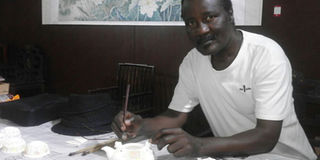Kenyan artist off to China for cultural residency programme

Kenyan artist Patrick Adoyo painting porcelain in China. PHOTO | COURTESY
What you need to know:
- The other artists are from Liberia, Senegal, Congo Brazzaville, Chad and Equatorial Guinea. Chengdu School of Culture and Art trains students in art, dance, theatre arts and gymnastics.
- In July, Adoyo, 61, held a month-long solo exhibition at the Banana Hill Art Gallery, titled, ‘Retiring to a Passion.’ He explains that he was in a shortlist of three Kenyan artists who were called to the Chinese Embassy for an interview.
- Adoyo, who recently retired from the National Museums of Kenya, where he was the head of the exhibits department, is the founder of the Lake Basin Art Group, which has been in existence since 2009.
That China has stamped its presence on Africa is not in doubt; what with the massive infrastructural projects opening up various parts of the continent, some which are said to leave the continent in crippling debt. From the look of things, the Chinese are taking the battle to win the heart and soul of Africa a notch higher.
China has now embarked on a cultural charm offensive and is determined to open up and deepen cultural ties with Africa. Kenya’s Patrick Adoyo is in a group six visual artists, drawn from various African countries, currently at the Chengdu School of Culture and Art in China, for a one-and-a-half months’ residency programme.
Apart from showcasing what they have to offer, the African artists will learn aspects of the Chinese art, the history of their art, which they will hopefully bring back home.
The other artists are from Liberia, Senegal, Congo Brazzaville, Chad and Equatorial Guinea. Chengdu School of Culture and Art trains students in art, dance, theatre arts and gymnastics.
Adoyo, who recently retired from the National Museums of Kenya, where he was the head of the exhibits department, is the founder of the Lake Basin Art Group, which has been in existence since 2009. Prior to his retirement last year, Adoyo had worked at the Museums for 20 years.
MANY SIMILARITIES
In July, Adoyo, 61, held a month-long solo exhibition at the Banana Hill Art Gallery, titled, ‘Retiring to a Passion.’
He explains that he was in a shortlist of three Kenyan artists who were called to the Chinese Embassy for an interview. “Out of the three, I was the only one who travelled to China,” he says. Adoyo has solid achievements in the field of visual art. He was in the technical team that oversaw the installation of art at the refurbished arrivals lounge of the Jomo Kenyatta International Airport.
This residency, he says “will be an eye-opener into the rich culture and art of the Chinese people, which has been in existence for thousands of years.”
Since they are working with a group of Chinese artists, the self-taught Adoyo says that the tour presents an opportunity for both sets of artists to learn from each other. “Everything we are working on is being documented for posterity; This is where Chinese art meets African art. After this, our works will be exhibited in a public gallery,” he adds.
In the land of Confucius, he explains, art plays a big role in almost every sphere of Chinese life. “You can see it in their homes, offices, roads, name it,” says Adoyo.
From observation and in the time he has spent in China, Adoyo says there is a lot of similarity between modern Chinese and African art. “The only difference could be in the finer details in Chinese art, as the Chinese undergo rigorous training from childhood, unlike in Africa, where most artists are self-taught.”
While at the residency, Adoyo and his group have been learning a few art techniques from the Chinese, like porcelain painting, which the Chinese are famous for.
All the knowledge he will have accumulated at the end of the residency, he says will be for the benefit of the young artists he is currently mentoring. And he has a word of advice for Kenyan artists: “As people who document history, artists should form the habit of producing art for posterity sake; not all art should be for sale.”
Through such exchanges, the Chinese will perhaps begin to heal the animus currently harboured by a section of Kenyan visual artists. In the recent past, Kenyan artists have viewed Chinese artists in poor light following the Venice Biennale debacle where, with collusion of crooked Culture ministry officials, slots at the Kenya stand at the prestigious Biennale showpiece were sold to Chinese artists in 2013 and 2015.




